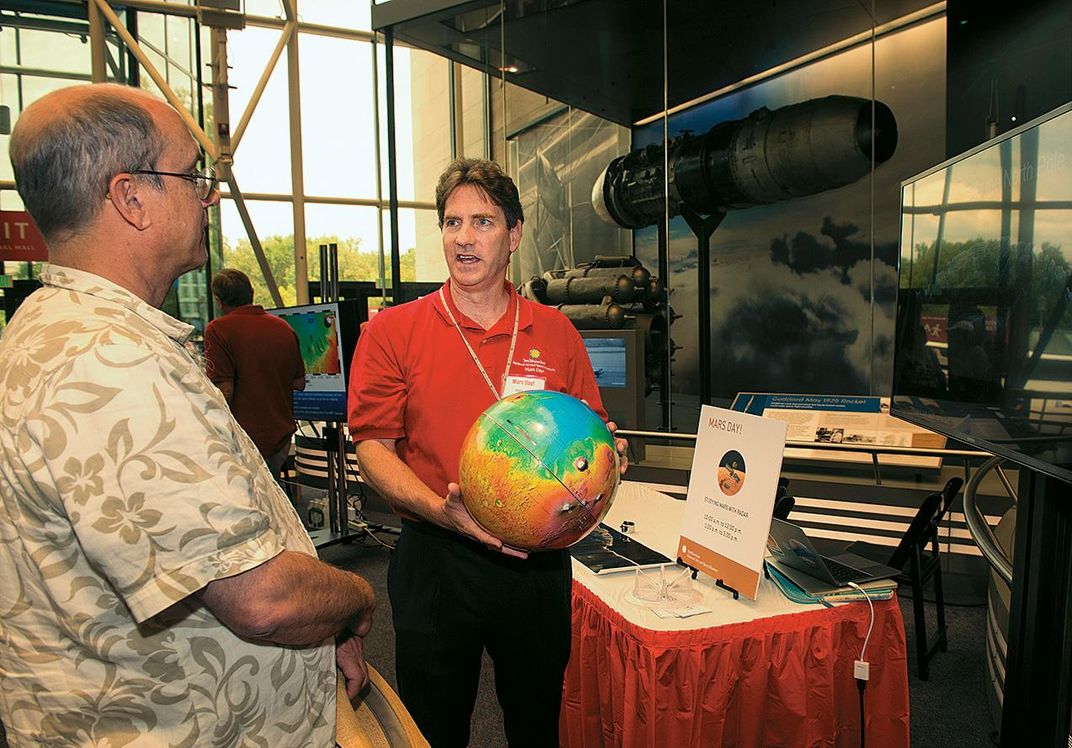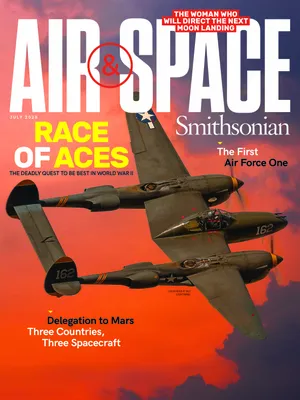Smithsonian Scientists Bring the Planets to the Public
A pair of researchers at the National Air and Space Museum want everyone to be able to tour the solar system.
:focal(1187x607:1188x608)/https://tf-cmsv2-smithsonianmag-media.s3.amazonaws.com/filer/67/6c/676c8b07-6b5a-4286-8263-5d72ef25774a/16b_jj2020_emilyfield_img_0730_live.jpg)
About the time Bruce Campbell was finishing graduate school, NASA’s Magellan mission arrived at Venus and started making the first global map of the alien world using synthetic aperture radar to penetrate the planet’s dense atmosphere. “The biggest draw was being able to look through the atmosphere,” says Campbell. “In a photograph, all you see is the golden color. But with the radar system, you can look right through the clouds and reveal the mysteries.”
By the time Campbell joined the National Air and Space Museum’s Center for Earth and Planetary Studies (CEPS) as a research scientist in 1992, Magellan had returned radar images of 98 percent of the Venusian surface. “My first Museum exhibit project was to update the Venus section of the Exploring the Planets gallery,” he says. The gallery highlights the history and achievements of planetary exploration, by both Earth-based telescopes and spacecraft. “We took a lot of the Magellan data for the Museum display,” says Campbell. “You want to get the excitement across. When we look at these radar images of Venus, we’re seeing these places for the first time ever. We’re finding new features like tesserae [highly deformed plateaus of crisscrossing mountains on Venus’s surface]. There is nothing on the Earth that we can point to where we can say, ‘Oh, tesserae are just like that.’ So we try to bring both the cutting-edge science and the excitement of that discovery process to people.”
There hasn’t been another U.S. mission to Venus since Magellan, but Campbell is hoping that will soon change. He’s working on two of the finalist projects being considered for funding under NASA’s Discovery program (low-cost planetary science missions having a budget of less than $500 million excluding launch and operations). Both would go to Venus: VERITAS would send an orbiter to map the planet’s surface, while DAVINCI+ would send a probe to descend through the planet’s atmosphere and make detailed measurements all the way to the surface.

Campbell’s work is typical of the role played by CEPS research scientists. As his colleague Emily Martin puts it, “A big part of what we do is to try and get our science out to the public. The Exploring the Planets gallery is the perfect place for us to highlight all the active research that’s going on in the Museum, and all the past, present, and future missions.”
Martin’s research is relevant to one of four recent Discovery proposals selected by NASA for concept development. She is part of the Trident mission team, which proposes to send a spacecraft to make a single, close flyby of Triton, Neptune’s largest moon, which may have an ocean beneath its icy crust.
“When I first started working at CEPS, I was very curious as to why we existed,” she says. “We don’t have objects to curate; our primary role is to do scientific research. We exist because of what the Museum was intended to be, which was a place where a lot of objects coming out of the Apollo missions were going to live for the rest of their physical lives. But there was so much data that came back from Apollo, and so much data that came from the preparation of Apollo, that there was still a lot of fundamental research that needed to be done. And that was a big impetus for the creation of our department.”
/https://tf-cmsv2-smithsonianmag-media.s3.amazonaws.com/filer/7e/2b/7e2bd7b7-fbfb-4c7f-8e00-c54b53e16890/16a_jj2020_exploringtheplanets_live.jpg)
The two Venus Discovery missions would advance the research begun by Magellan. The VERITAS radar would map Venus’s surface at a higher resolution than Magellan. “The other thing that VERITAS will do that Magellan was not able to do,” says Campbell, “is detect surface change. We know there’s a lot of heat that has to come out of a planet the size of the Earth or the size of Venus, and that heat has to get out somehow. Our best guess right now is that a lot of that heat is coming out by large magma plumes coming up from the mantle. It’s basically making the surface rise and fall as they come close to the top, then creating volcanoes.”
NASA will select two of the four missions—the fourth, the Io Volcano Observer, proposes to perform a series of flybys of Io, Jupiter’s innermost moon—for development in 2021.
If their projects are selected, both Martin and Campbell will likely spend the rest of their careers working on that data.
“We know because of missions like Voyager and others that these things last decades from planning, to launch, to execution,” says Martin. “Trident is no different. There was a distinct effort to have a multi-generational team to make sure there is continuity throughout the lifespan of this mission. We have people on our team helping to plan this mission who were on the Voyager encounter when it went to Triton back in 1989.”
In a mission like this, those with experience will train the newcomers. And once the data is gathered, all of that knowledge will be shared with the public, partly through new galleries and exhibits that CEPS scientists help create in the National Air and Space Museum.
